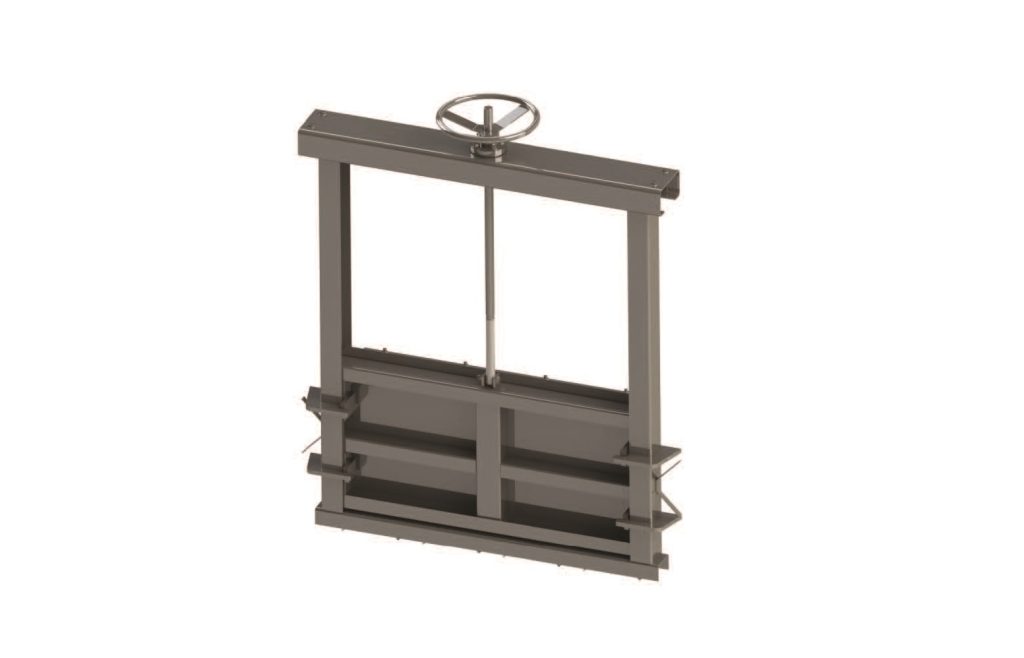By Mikko Syrjälä, Project Manager, Econet Oy
If a water treatment plant were an orchestra, the sluice gate would be the conductor’s hand guiding the flow, setting the pace, and keeping everything in sync.
In practice, it’s a sturdy steel or stainless gate that opens and closes inside a channel. It is critical in managing flows, processes and even safety throughout water and wastewater infrastructure.
I’ve worked with more sluice gates than I can count planning, dimensioning, replacing, and repairing. In this article, I’ll walk you through what a sluice gate actually does, where it’s used, and why it’s one of those “small things that make big things possible” in water treatment.
What Is a Sluice Gate?
A sluice gate is a movable barrier that controls water flow in channels, pipelines or treatment tanks. Think of it like a valve — but flat and often rectangular — that can be raised or lowered to start, stop or regulate water movement.
You’ll find sluice gates in all kinds of locations:
- Inlet structures at treatment plants
- Flow splitting points
- Overflow weirs
- Stormwater retention basins
- Equalisation tanks
- Industrial discharge channels
In short, a sluice gate might be your best friend anywhere you need to control water flow manually or automatically.

Why Are Sluice Gates So Useful?
1. Process control
Need to shut off a tank for cleaning? Divert the flow during maintenance? A sluice gate lets you do that cleanly, safely and with minimal downtime. And when you’re dealing with millions of litres of water, precise control is essential.
In many facilities, we design two or more parallel channels specifically to ensure maintenance can be done safely and without interrupting operations. Sluice gates make this possible by completely isolating individual channels or treatment steps whenever needed.
2. Emergency response
Sluice gates are often part of flood control or overflow prevention systems. When properly integrated, they give operators absolute control in fast-changing situations.
3. Simple, reliable mechanics
Compared to motorised valves, sluice gates are robust and easy to maintain. Many can be manually operated, a real advantage in locations without automation or electricity.
4. Built to last
At Econet, we deliver sluice gates made from acid-proof stainless steel, designed for decades of use in harsh conditions, including industrial wastewater with chemical loads.
Sluice Gate Types: From Overflow Control to Shut-Off Simplicity
Depending on the application, not all sluice gates are designed to do the same job. Here are the main types Econet works with:
Overflow gates work much like regular sluice gates, but instead of blocking the flow directly, they control how much water flows over the top of the gate. That makes them great for fine-tuning flow rates. In many cases, overflow gates are operated with electric or pneumatic actuators, and they can be used to shut off flow completely by raising the gate above the water line.
On/off gates are exactly what they sound like. They’re designed to either allow flow through a channel or stop it entirely. These are often used during maintenance to isolate parts of a process, like when we need to access equipment that would otherwise be underwater. We typically use electric actuators here, often backed up with a manual handwheel just in case.
Manual gates are the simplest and often the most cost-effective option. When the site conditions allow and frequent adjustments aren’t needed, a manually operated sluice gate is a solid, reliable choice.
The right gate type depends on the customer’s specifications. One size doesn’t fit all, and that’s where our design team comes in.
Mounting Methods: How Sluice Gates Are Installed
A well-chosen gate is only as good as the way it’s installed. The two most common installation methods are:
1. Cast-in-place installation
The frame is embedded directly into a concrete structure during casting. This gives the gate excellent strength and sealing performance and is the preferred method for new builds.
2. Surface mounting with anchor bolts
This is a quicker solution that is ideal for retrofits and renovations. The gate is fixed directly onto an existing wall or channel with wedge anchors. This is the go-to method when working with older plants or when customers need flexibility during installation.
Customers often have a clear preference for how they want their gates mounted, and we ensure our equipment is tailored to that choice.
One final but critical factor is material selection. The gate material must match the medium it comes into contact with. In environments with corrosive chemicals, we use acid-resistant stainless steel to ensure long-term durability.
What Does a Good Sluice Gate Look Like?
Here’s what I always look for when we design or supply a new sluice gate system:
- Tight sealing – prevents leaks and backflow
- Corrosion resistance – especially important in chemical or saline environments
- Easy manual operation – especially during power outages
- Custom sizing and frame options – not all channels are standard
- Proven in Nordic conditions – freezing temperatures, fluctuating flows and rough handling
Econet’s Perspective
In our water and wastewater projects, we often combine sluice gates with automated flow control, safety shut-offs, and adjustable overflow structures. The goal is always the same: a safe, flexible system that works—day in and day out.
Since we design the entire process and equipment under one roof, we know how the sluice gate fits into the bigger picture. It’s about keeping the system in balance, efficiently and reliably.
In Summary
A sluice gate may seem like just a piece of metal in a channel. But when you need to control, isolate or protect a process step, it becomes one of the most important tools in the plant.
They’re about flow, safety, control and keeping your system maintainable for decades to come.
If you’re planning a new system, modernising an old one, or just wondering whether your current gates are doing their job, let’s talk. There’s a lot we can help with.



